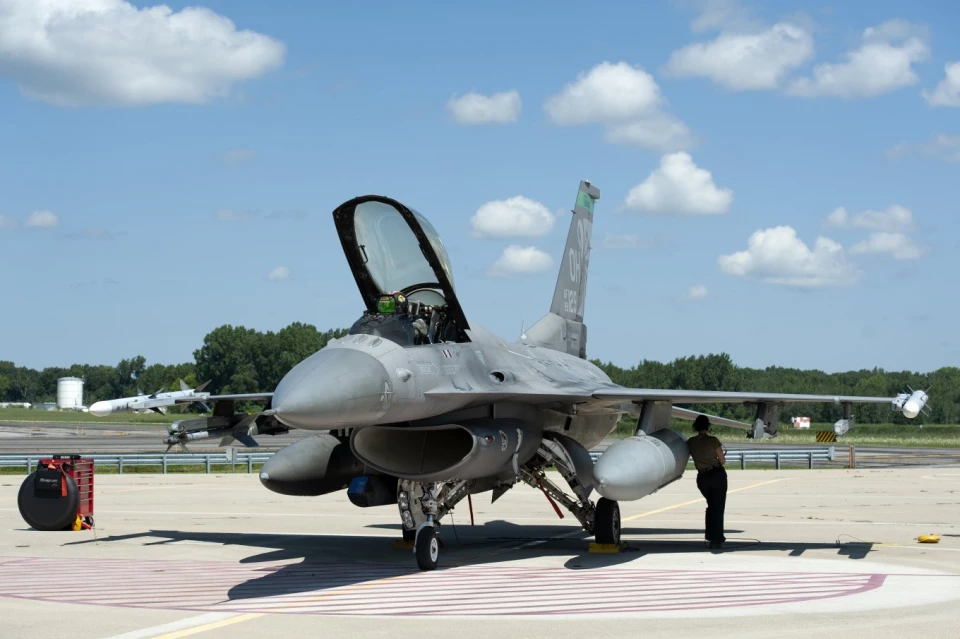
When F-16 fighters may appear on the front line. Column by Serhiy Zgurets
The training of pilots on modern fighter jets is happening rapidly, but the preparation process is progressing somewhat slower than Ukraine and its allies anticipated
On pilot training and the F-16
I'll start the military section with a series of topics that have been covered in foreign media and are worth paying attention to due to the importance of our security. First and foremost is the training of Ukrainian pilots for the long-awaited F-16 fighter jets. The American publication The New York Times reported on March 11, that 12 Ukrainian pilots will be ready for combat on F-16s this summer after 10 months of training in Denmark, the United Kingdom, and the United States.

But there are several interesting details here. The publication notes that the training of pilots on modern fighter jets has been lightning-fast, according to instructors' assessments. However, the preparation process is still progressing somewhat slower than Ukraine and its allies expected. The main issue here is that a certain amount of time was spent on preparation regarding mastering the technical language and technical details. Figuratively speaking, training began in August, but actual flights commenced only in January 2024.
Regarding the fighter jets, by the time these 12 pilots complete their training, Ukraine may only receive 6 F-16 fighter jets. Overall, we know that Denmark, the Netherlands, Norway, and Belgium have committed to sending approximately 45 aircraft to Ukraine, which amounts to 3 squadrons. However, the actual delivery of these aircraft will take place later, with only 13 expected to arrive by the end of the year. The rest will arrive around 2025, but the first 6 will arrive earlier. So, practically, we will have slightly more pilots than aircraft available this summer.
Regarding the maintenance of the F-16s, there are also interesting details. It turns out that we need between 8 to 14 mechanics for each aircraft. Currently, about 50 Ukrainian military personnel are undergoing training in Denmark as technicians. And this is only for the 6 aircraft.
Another topic is runway preparation. Here, we understand that the Air Force command is addressing this issue. Air Force spokesperson Yuriy Ihnat mentioned that we will not be constructing new airfields but will utilize existing ones. This is quite challenging because the enemy is currently attempting attacks on all our airfields. Therefore, securing these airfields is crucial. And this is a significant factor regarding the timing of aircraft delivery to Ukraine.
In my opinion, this material is not about betrayal but about a unique story because no country transitioning to the F-16 has done it as quickly as Ukraine is doing now. I believe that after the transfer of the first aircraft and gaining initial experience, the pace of aircraft delivery and training will be accelerated at the expense of utilizing other facilities.
Let's remember that there is a new training center in Romania, which is intended to become the main base for training our military personnel. I believe that everything will go according to plan, perhaps even faster. However, the main intrigue lies in the armament list because no foreign publication has yet mentioned the specific armament that will be provided with the F-16 fighter jets for Ukraine. I hope that this list will be sufficient to carry out missions for air defense and to support our forces engaged in combat operations on the ground.
On the Russian command post's destruction
Currently, the Ukrainian Air Force is conducting strikes against the enemy using MiG-29, Su-27, and Su-24 aircraft. Today, on March 11th, there was extremely interesting information from the Air Force Commander. Commander Oleshchuk thanked the pilots for accurately hitting a Russian command post. He wrote about thanking them for their successful work. The general did not provide any other details. However, it is mentioned that this command post was located on a barge grounded on a shoal.
Combat operations were conducted on March 11th in the Kherson region. Interestingly, there is currently hysteria spreading in Russian publications, suggesting that General Teplinsky may have been at this command post. On one hand, he is the commander of the Russian Airborne Troops, and on the other hand, he was responsible for the military grouping on the left bank of the Dnipro River. Teplinsky is considered a highly experienced general. If indeed Teplinsky was on this barge, it would be a unique situation to confirm the capabilities of our intelligence and our means of engagement.
Ammunition for Ukraine
Czech President Petr Pavel stated that in the coming weeks, Ukraine will start receiving ammunition discovered by the Czech Republic in other countries. We are talking about 800,000 ammunition, of which 500,000 are 155 mm caliber and the rest are 122 mm. Petr Pavel did not name the countries where the ammunition will be bought. However, experts have speculated that it could be South Korea, African countries, and Turkey. 800,000 rounds of ammunition is a powerful enough amount, because for defense purposes we need at least 90,000 rounds of ammunition per month for more active operations, and including offensive operations, we need somewhere over 200,000 rounds of ammunition per month.
The Stockholm International Peace Research Institute (SIPRI) released data showing that Ukraine became the largest European arms importer in 2019-2023. Ukraine is also the fourth largest importer of weapons after Russia's large-scale aggression against Ukraine began in 2022. This study notes that at least 30 countries have supplied Ukraine with major weapons as part of military assistance. And it is significant that our country's share in global arms imports, when we measure all global exports and imports, accounts for 5% of global imports, compared to 0.1% before the war with Russia.
According to SIPRI data, the main suppliers are the United States, Germany, Poland, and other countries. Ukraine received 66% of its weapons from these three states to resist Russian aggression. The main demand for imports in Europe amid the war with Russia is precisely for ammunition, artillery, and air defense systems. Currently, the demand for ground-based air defense systems has become significantly pronounced, which is accelerating the pace of production of such systems in several countries.
On supplying Taurus missiles to Ukraine
Let's also mention the news related to events of this day and week, which is the situation unfolding in Germany. For a long time, Ukraine has been requesting the supply of Taurus missiles from Germany. On March 11th, it became known that German Foreign Minister Annalena Baerbock supported the proposal of her British counterpart David Cameron to exchange cruise missiles between the UK and Germany, with Ukraine benefiting from this exchange. The proposal suggests that if Germany is currently hesitant to directly supply Taurus missiles to Ukraine under certain circumstances, then the alternative would be to provide these cruise missiles to Britain, which would then send an equivalent number of Storm Shadow missiles to Ukraine.
Such an exchange appears to be quite an interesting solution. However, it's important to understand that certain technical issues are being addressed in this regard. There are difficulties with integrating Taurus missiles onto the Su-24M aircraft used by Ukraine. Representatives of MBDA have mentioned that this process could take six months or more. Additionally, we are aware of the incident involving Russian eavesdropping on conversations of German generals discussing technical challenges related to using Taurus missiles to strike the Crimean Bridge. Nevertheless, I am confident that this entire story will not significantly delay Germany's supply of Taurus missiles. There might be an interim stage where these missiles could be transferred to the United Kingdom, and Storm Shadow missiles would then be provided to Ukraine.
The intrigue lies in which fighters, bombers, or multi-role aircraft Britain will use these German missiles on, as there are integration issues with British models as well. Nevertheless, it is crucial to emphasize the importance of urging European countries to continue providing significant support to Ukraine.
Situation at the front
Currently, the most challenging areas are Novopavlivka and Avdiivka. The Russian forces are attempting attacks around Novomykhailivka, but there have been no advancements against our forces. As for Avdiivka and the entire frontline stretching from the settlements of Berdychi, Orlivka, and further south, it's noteworthy that Ukrainian troops have conducted a series of counterattacks in this area, while there has been no movement from the aggressor's side.
Indeed, the current situation appears to be relatively under control, especially considering that over the past few days, the amount of ammunition used by the Ukrainian army on the front lines has increased. This indicates either replenishment or active utilization of reserves by our Armed Forces. This is a sufficient precondition to actively engage the enemy across the entire front line, as evidenced by the statistics provided by the General Staff of the Armed Forces of Ukraine regarding enemy losses daily.
- News














































